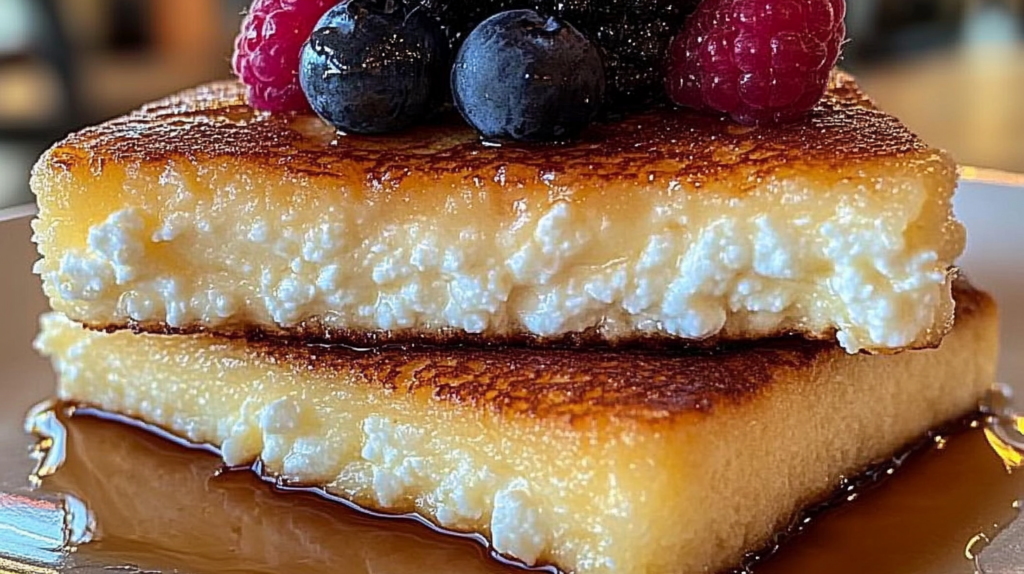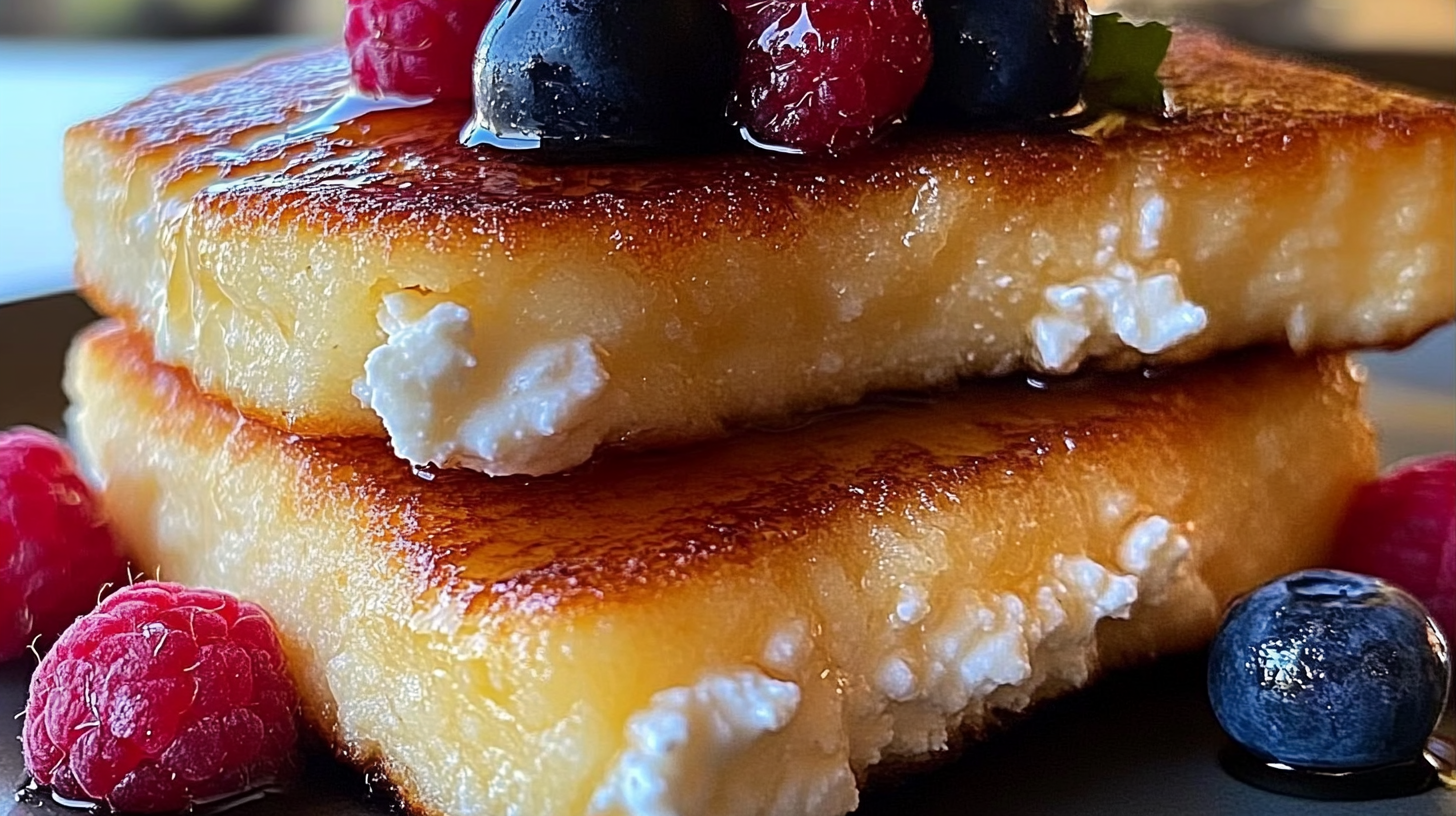Are you craving a stack of fluffy, satisfying pancakes but want to avoid traditional flour and oats? Look no further! These protein-packed cottage cheese pancakes are a game-changer for breakfast lovers who are watching their carb intake or simply want a nutritious alternative to traditional pancakes. With just a handful of simple ingredients, you’ll have a delicious, nutrient-rich breakfast on the table in minutes.
Why You’ll Love This Recipe
These cottage cheese pancakes have become my family’s weekend breakfast staple, and for good reason! First and foremost, they’re incredibly easy to make – just blend, cook, and enjoy. The absence of flour and oats makes them perfect for those following gluten-free, grain-free, or low-carb diets.
What makes these pancakes truly special is their impressive protein content. Each serving delivers a substantial protein boost thanks to the cottage cheese and eggs, helping you stay full and energized throughout your morning. The texture is surprisingly light and fluffy despite containing no traditional flour – you’ll be amazed at how similar they feel to regular pancakes!
Another fantastic aspect of this recipe is its versatility. You can easily customize these pancakes with your favorite mix-ins and toppings. Whether you prefer them sweet with berries and honey or savory with herbs and a dollop of sour cream, these pancakes provide the perfect canvas for your culinary creativity.
Best of all, they’re kid-approved while being parent-approved for their nutritional profile. It’s rare to find a healthy breakfast that doesn’t feel like a compromise, but these cottage cheese pancakes deliver on both taste and nutrition.

Ingredients
To make these delicious flour-free and oat-free cottage cheese pancakes, you’ll need:
- 1 cup full-fat cottage cheese
- 4 large eggs
- 2 tablespoons coconut flour (optional, for structure)
- 1 teaspoon vanilla extract
- ½ teaspoon cinnamon
- 1 tablespoon granulated sweetener of choice (honey, maple syrup, or stevia)
- ¼ teaspoon baking powder
- Pinch of salt
- Butter or coconut oil for cooking
The cottage cheese serves as the base for these pancakes, providing both structure and a creamy texture. Look for a small-curd variety for the smoothest results. The eggs act as both a binding agent and leavening, helping these pancakes rise and achieve a fluffy texture without traditional flour.
While this recipe doesn’t require traditional flour or oats, the small amount of coconut flour helps absorb moisture and create a more traditional pancake texture. Don’t worry if you don’t have it on hand – the pancakes will still turn out delicious, just slightly more delicate.
Directions
Creating these cottage cheese pancakes is surprisingly simple and requires minimal effort. Follow these steps for perfect results every time:
- Blend the batter: Place cottage cheese, eggs, coconut flour (if using), vanilla extract, cinnamon, sweetener, baking powder, and salt in a blender. Blend on high for 30-45 seconds until the mixture is completely smooth and no cottage cheese curds are visible. The batter should have a slightly thick, pourable consistency.
- Rest the batter: Allow the batter to rest for 5 minutes. This gives the coconut flour time to absorb moisture and the baking powder a chance to activate.
- Heat your pan: While the batter rests, preheat a non-stick skillet or griddle over medium-low heat. Add a small amount of butter or coconut oil to coat the surface.
- Cook the pancakes: Pour about ¼ cup of batter for each pancake onto the heated surface. Keep the pancakes relatively small (about 3-4 inches in diameter) as they’re easier to flip this way.
- Watch for bubbles: Cook until bubbles form on the surface and the edges begin to look set, about 2-3 minutes. These pancakes won’t bubble as much as traditional pancakes, so look for the edges to appear dry and slightly golden.
- Flip with care: Gently flip each pancake and cook for an additional 1-2 minutes until golden brown on both sides and cooked through.
- Keep warm: Transfer cooked pancakes to a plate and keep them warm in a low oven (about 200°F/95°C) while you cook the remaining batter.
The key to perfect cottage cheese pancakes is patience with the cooking process. Because these pancakes don’t contain gluten or traditional flour, they need to be cooked at a slightly lower temperature for a bit longer than regular pancakes.
Serving and Storage Tips
These protein-rich pancakes are delicious served warm right off the griddle. For a complete breakfast experience, try these serving suggestions:
- Top with fresh berries, sliced bananas, or diced peaches
- Drizzle with pure maple syrup, honey, or a sugar-free syrup alternative
- Add a dollop of Greek yogurt and a sprinkle of granola for extra texture
- Spread with almond butter or peanut butter for additional protein
- Serve with a side of crispy bacon or turkey sausage for a savory contrast
If you have leftovers (which rarely happens in my house!), these pancakes store beautifully. Allow them to cool completely, then place them in an airtight container with parchment paper between layers to prevent sticking. They’ll keep in the refrigerator for up to 3 days.
For longer storage, freeze the pancakes in a single layer on a baking sheet, then transfer to a freezer bag once solid. They’ll maintain their quality for up to 3 months. To reheat, simply pop them in the toaster or microwave until warmed through.
These pancakes are also perfect for meal prep. Make a double batch on Sunday, store in the refrigerator, and enjoy quick, nutritious breakfasts throughout the busy week.
Helpful Notes
After making these pancakes dozens of times, I’ve gathered some helpful tips to ensure your cottage cheese pancakes turn out perfectly:
- Texture matters: For the smoothest pancakes, blend the batter thoroughly until no cottage cheese curds remain visible.
- Temperature control: Cook these pancakes over medium-low heat rather than high heat. The lower temperature allows them to cook through without burning.
- Size consideration: Keep the pancakes small (about 3-4 inches in diameter) to make flipping easier. These pancakes are more delicate than traditional flour pancakes.
- Mix-in options: For flavor variations, try folding in blueberries, chocolate chips, or chopped nuts after blending the batter.
- Savory version: Omit the sweetener and vanilla, and add herbs like chives or dill with a pinch of garlic powder for a savory alternative.
- Consistency adjustment: If your batter seems too thin, add an additional tablespoon of coconut flour. If it’s too thick, a splash of milk will help achieve the right consistency.
Remember that these pancakes will have a slightly different texture than traditional pancakes – they’re a bit more custardy in the center while still maintaining a satisfying pancake feel.
Frequently Asked Questions
Can I use low-fat cottage cheese instead of full-fat? Yes, you can use low-fat cottage cheese, but the pancakes might be slightly less rich and satisfying. The fat in full-fat cottage cheese contributes to the tender texture of these pancakes.
Is there a dairy-free alternative to cottage cheese for this recipe? While cottage cheese is central to this recipe, some people have reported success using a thick, plain dairy-free yogurt alternative mixed with a bit of dairy-free cream cheese to mimic the texture and protein content.
Why aren’t my pancakes fluffy? The most common reason is either not enough baking powder or overmixing the batter after adding the baking powder. Also, make sure your baking powder is fresh for optimal rising.
Can I make the batter ahead of time? I recommend making the batter fresh before cooking, as the baking powder will lose its effectiveness if the batter sits too long. However, you can prepare the pancakes completely and reheat them as needed.
Are these pancakes keto-friendly? With approximately 4-5g of carbohydrates per serving, these pancakes can fit into most keto meal plans, especially if you use a sugar-free sweetener.
Final Thoughts
These flour-free, oat-free cottage cheese pancakes have transformed my morning routine, providing a nutritious, delicious breakfast option that doesn’t leave me feeling weighed down. The beautiful balance of protein and healthy fats keeps hunger at bay until lunchtime, while the customizable nature of the recipe ensures breakfast never becomes boring.
What I love most about these pancakes is how they’ve changed my family’s perception of “healthy” food. No one would guess these pancakes are packed with protein and free from traditional flours – they simply taste like a delicious breakfast treat.
Whether you’re following a specific dietary plan or simply looking to incorporate more protein into your breakfast routine, these cottage cheese pancakes deserve a spot in your recipe collection. Give them a try this weekend – I’m confident they’ll become a new favorite in your household just as they have in mine!
Happy cooking and even happier eating!
